How can I help you? Welcoming words to a troubled gardener. As summer marches on, I’m regularly asked about problems that crop up in the garden. Here are some tips and advice for situations you also may be encountering.
Zucchini squash, th at fasted growing and most prolific of all summer squash, has many uses. Rather than bribe neighbors to take your giant zucchini, check the plants often and harvest them when small – the size of your finger . The flesh of these gourmet delicacies is soft and sweet at this stage.
at fasted growing and most prolific of all summer squash, has many uses. Rather than bribe neighbors to take your giant zucchini, check the plants often and harvest them when small – the size of your finger . The flesh of these gourmet delicacies is soft and sweet at this stage.
Zucchini, as with all summer squashes and winter squash such as pumpkins, bear two kinds of flowers on the same plant. The female flower contains the ovary that will develop into the fruit itself. For every female flower, there are at least three male flowers which produce the pollen. Bees do the job of carrying pollen from the male to the female flowers. That’s why it’s important to plant flowers and shrubs that attract bees. Remember not to use pesticides ,even organic neem oil and spinosad , when bees are present.
After the female flower has faded and begins to form fruit, the role of the male flower is over. Your zucchini plant may end up with lots of excess male flowers that are edible and can be prepared in a variety of delicious ways. You may have heard of squash blossom soup or baked stuffed squash blossoms but if you go for simple recipes try making quesadillas.
After cutting the stem from the bottom of the blossoms, spread several in a single layer over half of a large flour tortilla. Top with mozzarella or your favorite cheese, fold the tortilla over and let it heat gradually and both sides. When the cheese is fully melted and the blossom have collapsed, your culinary delight is ready.

